Iran Press/ Iran News: Naqsh-e Jahan Square, or Meidan-e Emam (also Shah Square and Imam Square), is the main tourist spot of Isfahan, one of the UNESCO World Heritage Sites. Naqsh-e Jahan in Farsi means “The image of the world”. Naqsh-e Jahan Square is 160 meters wide by 560 meters long, which results in a total area of 89,600 square meters. It is surrounded by two-story row of shops, reflecting the architectural style of the Safavid Era.
 Naqsh-e Jahan Square from an aerial view depicting its magnificence
Naqsh-e Jahan Square from an aerial view depicting its magnificence
History of Naqsh-e Jahan square:
Naqsh-e Jahan Square was built between 1598 and 1629 by the decision of Shah Abbas. In 1598 Shah decided to move the capital of the Persian Empire from Qazvin to Isfahan as a more secure and convenient place. To commemorate the new role of Isfahan and also to create a place to hold national events, Naqsh-e Jahan Square was designed.
 Oil painting exhibiting Naqsh-e Jahan Square
Oil painting exhibiting Naqsh-e Jahan Square
Sheikh Bahai became the leading architect of the project. Since the political strategy of Shah Abbas was concentrated on centralizing the power structure of Iran, the main idea of the project was to reflect all the components of power. So the square is surrounded by several buildings, where the Royal mosque ( now Imam Mosque) represents the power of the clergy, the Imperial Bazaar represents the power of merchants and Ali Qapu Palace represents the power of Shah Abbas.
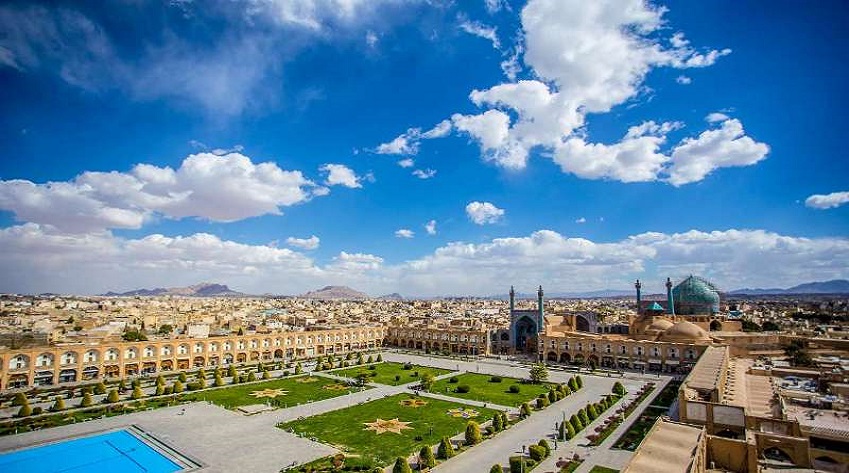 The square continues to beat as the heart of Isfahan
The square continues to beat as the heart of Isfahan
During the day the square was a place for trade, full of sellers’ tents. On evenings, when the sound of bargain vanished, the square turned into an entertainment site with jugglers, acrobats, dervishes and curious citizens. Other events, such as Nowruz or polo matches were also held on the square.
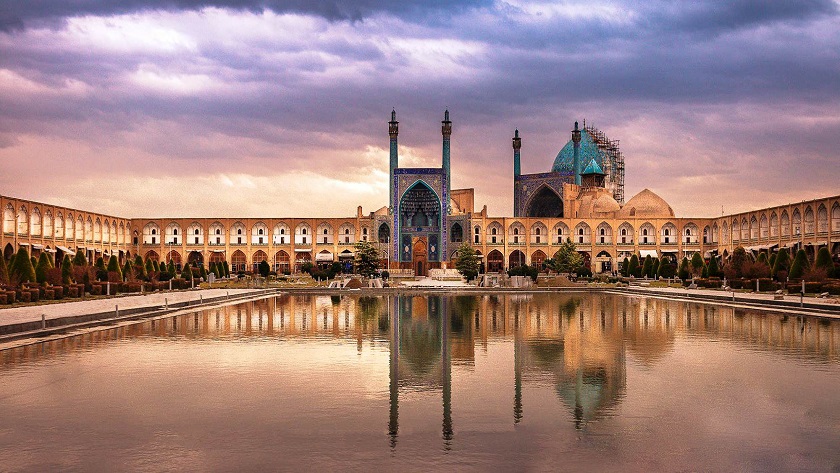 Reflection of Imam mosque on the pond
Reflection of Imam mosque on the pond
Naqsh-e Jahan Square in the Safavid era when Isfahan was the capital city of Iran has been one of the big gardens in the city, construction of which has been ordered by the seventh king of Safavids so that it would be used for the military parades, religious and mourning occasions, festivals and such entertainments as the game of polo (chogan). According to the historians, the construction of such unique complex has been ordered by Shah Abbas with the aim of showing off the glory and grandeur of his kingdom and Iranians to neighboring countries.
 The skyline of the square
The skyline of the square
After overthrown of the Safavids and especially during Qajar era, the square lost its prosperity; however, today it has been renovated and a new spirit has been injected into this valuable historical monument so that it has been turned again into a center for political and religious gatherings, at the central part of Iran. Still, some important events in Isfahan are held at this place.
 One of the most beautiful squares in the world
One of the most beautiful squares in the world
Architectural significance:
The UNESCO World Heritage Site is one of the largest squares in the world, justifying its English translation as "Image of the World".
Naghshe Jahan Square is one of the most important urban spaces in Iranian architecture. Considering the interactivity of this square with the surrounding urban spaces, there has been a significant number of entries in different periods.
Ali Akbar Esfahani and Mohamad Reza Esfahani are two of the architects who designed the square and built it in its present form. The names of these two architects are written on the portal of the Jame Abbasi Mosque and in the Mehrab of Sheikh Lotfollah Mosque.
 The royal palace of Ali Qapu
The royal palace of Ali Qapu
Imam's mosque: Shah Mosque is the most important mosque in Isfahan, used as a place for prayer and lectures of Safavid Kings. The mosque has become renovated and completed during different periods and many architects have contributed to the construction of the complex. The mosque is one of the biggest mosques in Iran and its tile works and woodcrafts are unique among their peer groups. This historical place has been of such importance for kings that controlling it has been resembling controlling Naqsh-e Jahan Square and the whole of Isfahan.
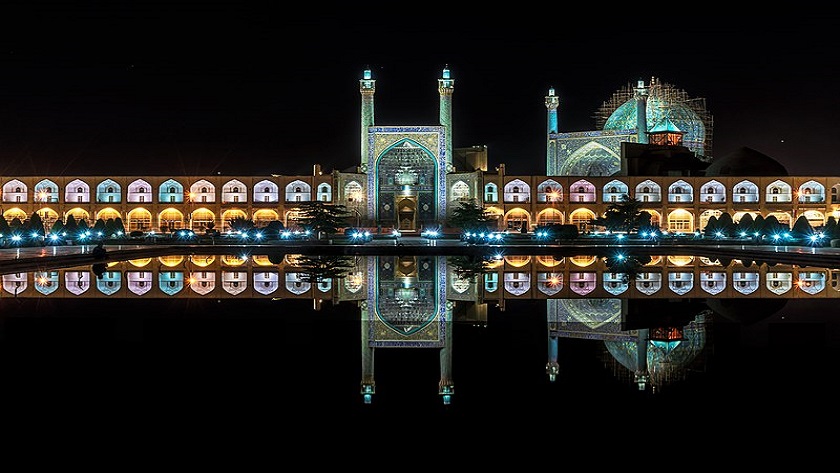 Imam mosque crown jewel of Isfahan's architecture
Imam mosque crown jewel of Isfahan's architecture
The glorious square symbolizes the excitement of the Safavid era when Isfahan became the capital of Persia. Originally designed to hold national events and glorify the new capital, the architects of Naqsh-e Jahan had lofty goals. Back in the day, it was used for celebrations, public executions, polo matches and assembling troops.
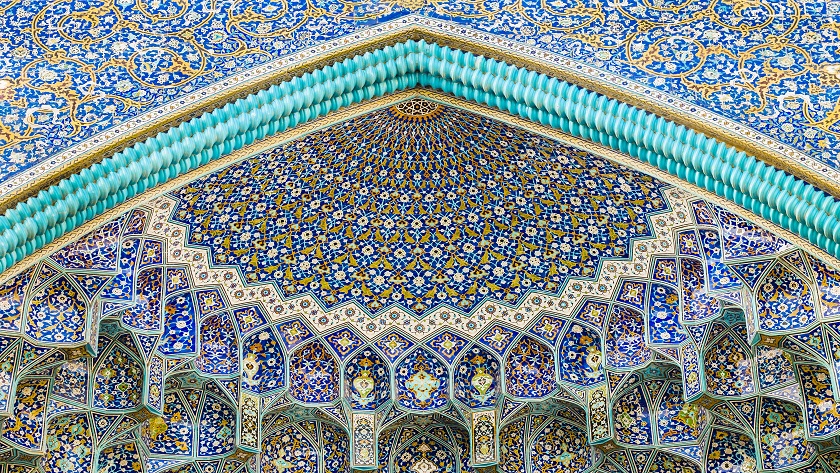 Gorgeous tiles depicting Iranian art at its best
Gorgeous tiles depicting Iranian art at its best
Ali Qapu Palace: On the west side of Naqsh-e-Jahan, the most spectacular Isfahan square, stands the entrance to the royal residence of the Safavid era. The term Ali Qapu consists of the Arabic word Ali meaning high and the Turkish word Qapu meaning portal. Ali Qapu was a place of multiple functions. On one hand, it was the place in which royal banquets were held; on the other hand, it was the place from which the king observed games of cricket held on Naqsh-e-Jahan.
 The large square is surrounded by historic sites including the impressive Ali Qapu Palace
The large square is surrounded by historic sites including the impressive Ali Qapu Palace
Isfahan's grand bazaar:
The Bazaar of Isfahan is a historical market and one of the oldest and largest bazaars of the Middle East. Although the present structure dates back to the Safavid era, parts of it are more than a thousand years old, dating back to the Seljuq dynasty. It is a vaulted, two kilometer street linking the old city with the new.
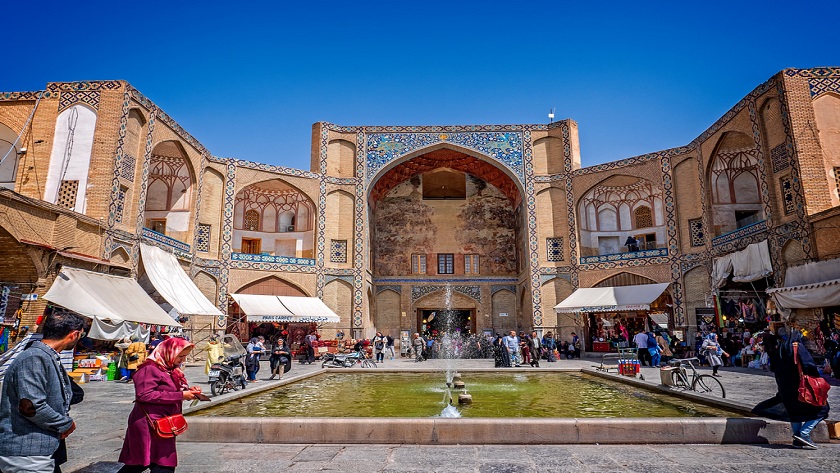 The Qeysarie gate, the main entrance of the Bazaar of Isfahan
The Qeysarie gate, the main entrance of the Bazaar of Isfahan
Sheikh Lotfollah Mosque: The mosque has been constructed in Naqsh-e Jahan Square in Isfahan so that Shah Abbas pays tribute to Sheikh Lotfollah Missi. Currently, its beautiful dome is shining like a jewel at top of the building. Using Islamic patterns; and, verses of Quran designed on the walls of the mosque have turned the mosque into one of the most beautiful Mosques in Iran.
The Lotfollah Mosque had a secret entrance that spanned underneath the Maidan, from the Palace on the opposite side of the square.
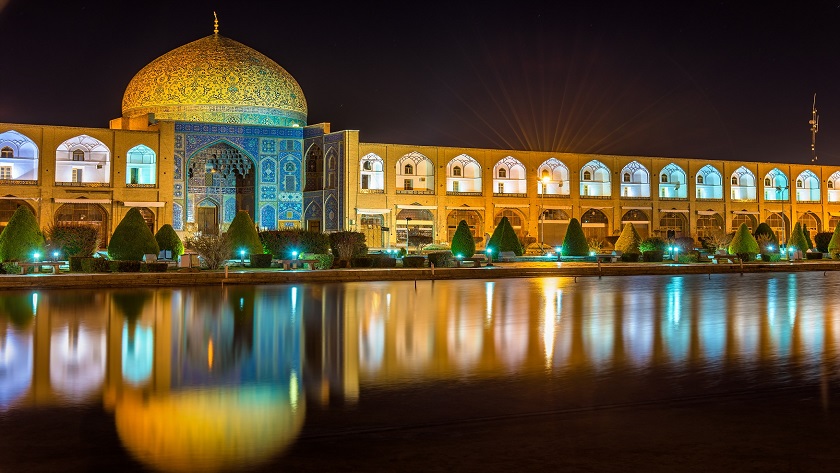 Sheikh Lotfollah Mosque
Sheikh Lotfollah Mosque
Tourism
Naqsh-e Jahan Square is the perfect place to do your souvenir and sweets shopping. There are not only a plethora of shops scattered around, the entrance to the city’s Bazaar is also located in this vital Isfahan square. It stands great and magnificent on the northern side of the square and welcomes people from all around the world.
Read More:
Isfahan's Nagsh-e Jahan Square registered as a World Heritage property
Ashkan Salehian

